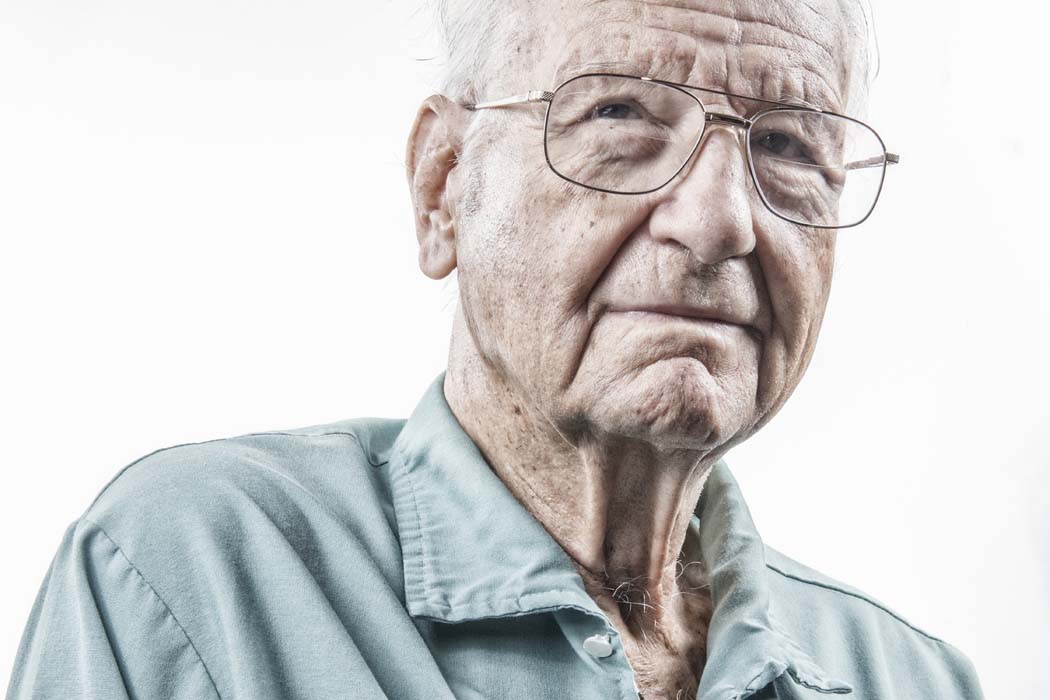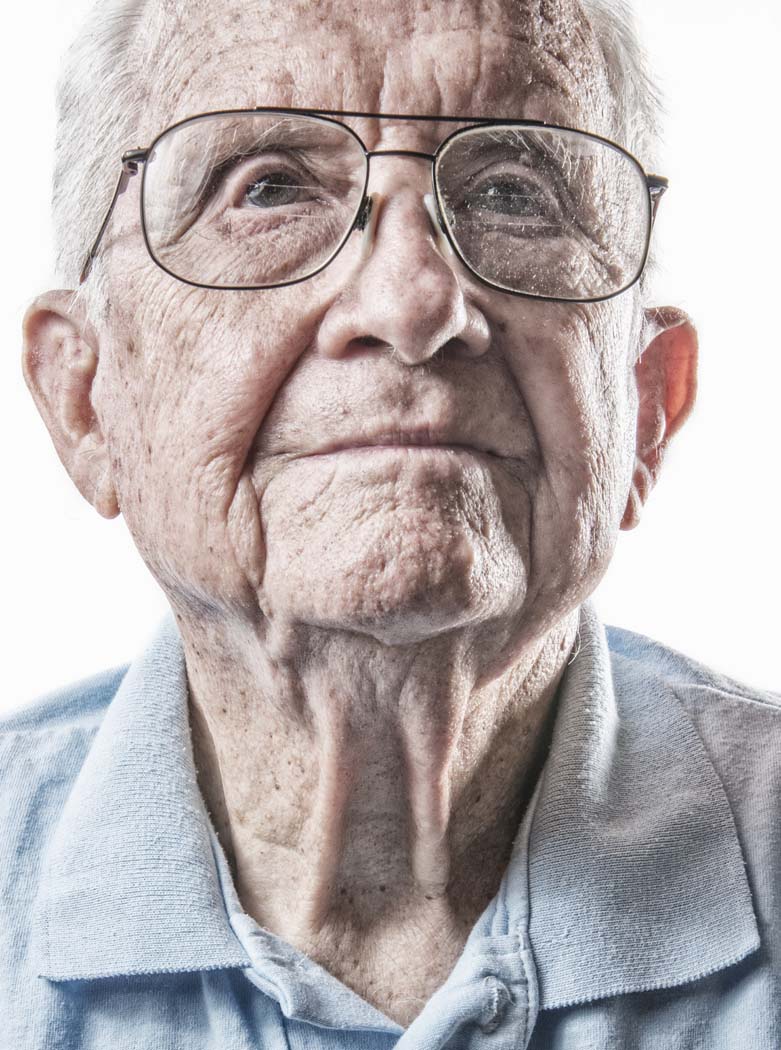There’s a reason they’re called “The Greatest Generation.” Some 400,000 Americans gave their lives fighting in World War II. Many thousands of others made it home, though wounded physically and mentally by the horrors of war. Some of those who served, however, never saw combat. Their service was behind the scenes instead of on the front lines. Even so, their military time impacted the war effort in ways big and small.
Lucky Lawhorn

Bill Lawhorn poses for a portrait at his dental practice in the Oak Cliff neighborhood of Dallas, TX on Oct. 2, 2015. During WWII, Lawhorn served as a radio operator in the Pacific Theater. He later attended dental school. Photo by Danny Fulgencio
William J. Lawhorn always has been lucky.
About a week before training started, all but eight of the servicemen in his Air Force squadron were called to the Army. Many of them wound up in the infantry, fighting in the Battle of the Bulge.
Lawhorn went to radio school.
He was stationed in Sioux Falls, N.D., Scott Field, Ill. and Roswell, N.M. After that, he was shipped to Kwajalein Island in the South Pacific. But by then, the United States already had dropped atomic bombs on Hiroshima and Nagasaki.
“The Marines had already cleaned it all up,” he says.
The Rockwall native, now 89, attended the University of North Texas on a football scholarship. He wanted to be a doctor, but he says he couldn’t pass organic chemistry. So he moved to Lufkin to teach school and married his UNT sweetheart, Anna.
“I had to go to the dentist, and he charged me about three-weeks salary for a small filling, so I figured I’d try to go to dental school,” he says.
He was accepted as part of the very first class at the University of Texas School of Dentistry in Houston. Eventually, he passed organic chemistry.
“Of course, I cheated,” he says.
One of his study partners had copies of three of the old professor’s previous tests. Lawhorn memorized them, and he got lucky. The test he took was one he had memorized.
He graduated from dental school in 1959 and set up office in Oak Cliff, first in Westmoreland Heights and then on Illinois near Hampton, where he still works three days a week. That’s right. Lawhorn is 89, and he still practices dentistry.
In the heyday, there were partners and hygienists and a receptionist. Now it’s just the two of them — Anna runs the business, and Bill checks the teeth.
At the height of his career, Lawhorn was an Oak Cliff civic leader, volunteering a few days a month to work on the teeth of underprivileged children. He served as president of the Oak Cliff Lions Club in 1985; he was also a Master Mason and a Shriner.
He and Anna reared three children in Oak Cliff and traveled the world, visiting the Great Pyramid at Giza and the Great Wall of China among many other destinations, places he could hardly imagine when he was growing up during the Great Depression, sacking groceries at the A&P.
He still remembers his dad shedding tears as he put him on the train to Fort Sam Houston in 1943. But Lawhorn was lucky. He was never shot at and never saw combat.
“I’ve had triple bypass and every kind of operation. All the doctors at Methodist know me,” he says. “They say, ‘Oh my gosh, here comes Lawhorn. I wonder what we’re going to have to cut out now.’”
If he’s lucky, he’ll make it to 100 or so.
Waves of Hensley Field

Marge Harrington, 94, poses for a portrait at Grace Presbyterian Village, a senior living and health service, in Dallas, TX on Oct. 5, 2015. During WWII, Harrington worked as a secretary for the US Navy in Arlington, TX. Originally from Boston, MA, Harrington said she was thrilled to escape the Northeastern winters. Harrington said she met a sailor after the war and, with a laugh, added, “I now have 11 grandchildren and 27 great grandchildren. I can’t remember any of their names.” Photo by Danny Fulgencio
Margie Harrington turned 21 in December 1942.
A secretary at an insurance company, she’d never been far from her hometown, Boston.
“I joined the Navy to see the world, and I saw Grand Prairie,” she says.
Arriving at Union Station, the Women Accepted for Volunteer Emergency Service (WAVES) recruit was “heartsick” to see the paved streets, automobiles and tall buildings of Downtown Dallas. She’d thought it would look like the Old West of the movies.
“But that’s alright,” she says. “It was my choice.”
Harrington served all three years of her Navy career at Hensley Field.
She started out as a secretary and went to work in public relations.
As part of her job, she met movie stars Robert Taylor and Tyrone Power when they visited the base. And she once spent an entire day with comedian Red Skelton, when he broadcast his national radio show live.
“He was a perfect gentleman,” she says. “He was cracking jokes the whole time.”
It was a dark time in American history, but Harrington managed to serve her country while having fun.
The Navy trained fighter pilots at Hensley Field, hundreds of them, Harrington says. When the instructors flew solo hours to maintain their certifications, they would use sandbags to weight the planes. Sometimes, the WAVES got to “act like sandbags,” Harrington says. They regularly went tooling around in open-canopy fighter planes.
She also used her military I.D., good looks and charm to travel to San Francisco, Washington, D.C., Florida and other points. There was always a plane you could hop on, she says.
In December 1943, Harrington’s WAVES pals offered to take her to dinner at the Chicken Shack on Fort Worth Avenue for her birthday. She arrived early.
While she waited, four servicemen came in, all of them on leave. One by one, she says, each guy asked her to come sit at their table. She politely told them she was waiting for her friends. When they arrived, the waitress said, “I have a table for you.”
“She walked us right to those boys,” Harrington says.
Afterward, they went to a movie at the Palace Theater downtown. Seven of them piled into a car, and the tiny Harrington was the last one in.
“There wasn’t anyplace to sit but this sailor’s lap,” she says. “And, anyway, he’s the one I ended up marrying. So I sat in his lap before I even knew him.”
When she put in her papers in 1946, Harrington’s supervisor offered to make her a chief petty officer to re-up. By then, she was editor of the base newspaper. But she had been living in an open barracks with 100 women for three years and was ready to go home.
She attended Columbia University for a year before getting married. She and her husband, John Clayton Harrington, moved to his family farm in Ferris. They reared three children in Wilmer-Hutchins. They have 11 grandchildren and 24 great-grandchildren. Clayton Harrington died in 1994, and Margie Harrington moved to Grace Presbyterian Village in 2008.
She turns 94 in December.
French liberation

Jim Walston poses for a portrait at his home in the Oak Cliff neighborhood of Dallas, TX on Oct. 1, 2015. Walton served as an assistant crew chief to B-24 bombers based in Britain during WWII. After the war, Walston worked as an aircraft engineer for the Vought corporation. After retiring from Vought, Walston volunteered at the Frontiers of Flight Museum in Dallas, TX. Photo by Danny Fulgencio
Jim Walston loves airplanes.
The 92-year-old Oak Park Estates resident dedicated his life to them.
It started before he was born, when his father was an airplane mechanic in World War I.
Walston enlisted in 1943 and was assigned as a mechanic to the 466th Bomb Group of the Eighth Air Force and served in England.
He worked on B-24 bombers, including one called the “Laden Maid,” which flew dozens of missions.
The mechanics worked on the runways, under no cover, in all weather. The Italy, Texas native remembers the bitter cold and deep snow of the winter of ’45, when he manually cleaned snow and ice off of airplane wings.
And he remembers D-Day, although he had no idea what was happening at the time. It started at 2:50 a.m. and continued late into the night. Walston keeps binders with detailed information on planes, pilots and missions from that time.
“They wanted 50 airplanes available for the first [D-Day] mission and 36 for the next two missions. That meant we needed nearly every airplane,” he says. “There were more airplanes flying that day than any other time.”
There were 78 planes in Walston’s group, and they all returned from the war. Following the liberation of France, in June ’45, Walston returned with his B-24 crew, via Iceland and Canada, to the United States.
This summer, the French government awarded Walston its medal of Knight in the French Order of the Legion of Honor, which is presented to those who aided in the liberation of France from Germany in World War II.
“I never shot at any Germans,” he says. “But I qualified for it.”
He later received an engineering degree from Texas A&M University and went to work for Vought Aircraft in Grand Prairie.
He worked for 37 years in its test lab and he touched about every plane that was produced there. The last plane he worked on as an employee was as Northrop Grumman’s B2 Spirit, the famous “Stealth Bomber,” in 1988.
But his retirement that year was not the end of his wrenching on planes.
As part of the Vought Retirement Club, he spends 10 hours a week or more restoring vintage planes. In all, the club has restored eight planes, several of which are displayed at the Frontiers of Flight Museum.
His wife died recently, after about a year in a nursing home. A longtime member of Cliff Temple Baptist Church, he is sustained by his faith.
These days, he’s excited about the plane he’s working on, a 1932 biplane called the Vought O3U-3 Corsair.





